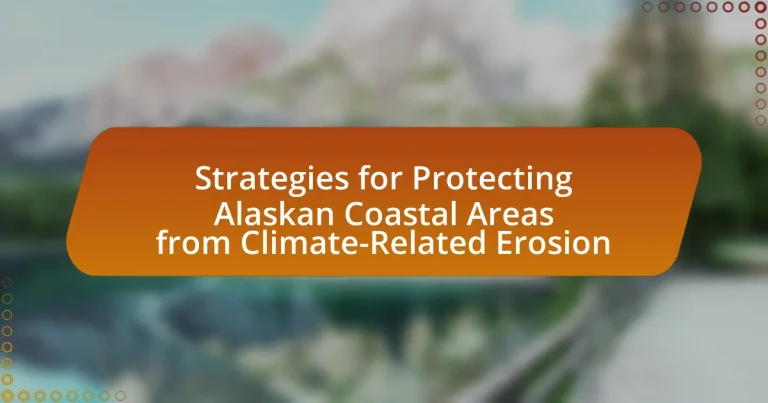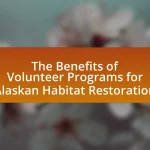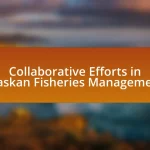The article focuses on strategies for protecting Alaskan coastal areas from climate-related erosion, highlighting the main challenges such as increased storm intensity, rising sea levels, and permafrost thawing. It examines how climate change accelerates erosion, the socio-economic implications for local communities, and the cultural impacts on Indigenous populations. The article also discusses various erosion management strategies, including engineered solutions like seawalls and natural methods such as beach nourishment and vegetation restoration. Additionally, it emphasizes the importance of community involvement and policy frameworks in enhancing erosion protection efforts, along with funding opportunities and best practices for effective management.
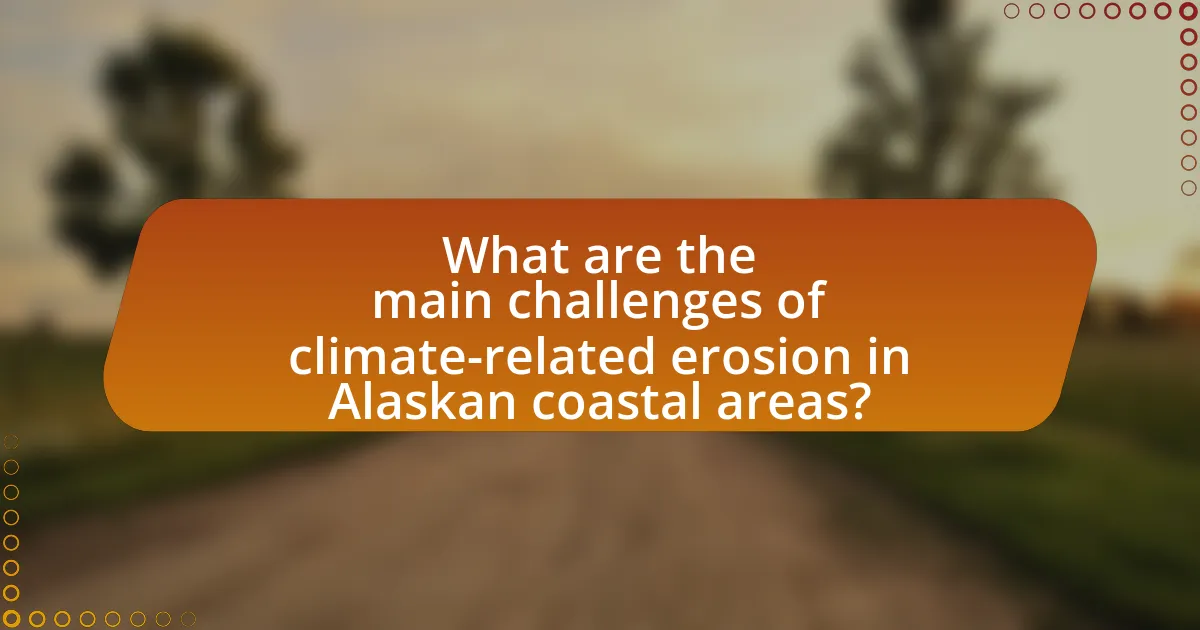
What are the main challenges of climate-related erosion in Alaskan coastal areas?
The main challenges of climate-related erosion in Alaskan coastal areas include increased storm intensity, rising sea levels, and permafrost thawing. Increased storm intensity leads to more frequent and severe wave action, which accelerates shoreline erosion. Rising sea levels, projected to increase by up to 1.2 meters by 2100, further inundate coastal areas, exacerbating erosion rates. Additionally, the thawing of permafrost destabilizes the ground, causing land subsidence and increased vulnerability to erosion. These factors collectively threaten infrastructure, ecosystems, and local communities, highlighting the urgent need for effective erosion management strategies.
How does climate change specifically impact coastal erosion in Alaska?
Climate change significantly accelerates coastal erosion in Alaska by increasing the frequency and intensity of storms, which leads to higher wave energy and flooding. As Arctic temperatures rise, permafrost thaws, destabilizing coastal land and contributing to erosion rates that can exceed 10 meters per year in some areas. According to the U.S. Geological Survey, coastal erosion in Alaska has been exacerbated by a reduction in sea ice, which traditionally acts as a buffer against wave action. This combination of factors results in the loss of land, threatening infrastructure and ecosystems along the Alaskan coast.
What are the primary factors contributing to increased erosion rates?
The primary factors contributing to increased erosion rates include climate change, human activities, and natural processes. Climate change leads to rising sea levels and increased storm intensity, which exacerbate coastal erosion. For instance, a study by the National Oceanic and Atmospheric Administration (NOAA) indicates that sea levels along the Alaskan coast have risen by approximately 1.2 millimeters per year, contributing to higher erosion rates. Human activities, such as construction and deforestation, disrupt natural sediment flow and increase vulnerability to erosion. Additionally, natural processes like wave action and river flow continuously shape coastlines, but their impact is intensified by the aforementioned factors.
How do rising sea levels affect coastal communities in Alaska?
Rising sea levels significantly threaten coastal communities in Alaska by increasing flooding, eroding shorelines, and damaging infrastructure. For instance, the village of Newtok has experienced severe erosion, losing over 70% of its land area since the 1970s, which has forced residents to consider relocation. Additionally, the National Oceanic and Atmospheric Administration (NOAA) projects that sea levels in Alaska could rise by up to 6.6 feet by the end of the century, exacerbating these issues. This combination of flooding and erosion not only impacts homes and public facilities but also disrupts traditional subsistence lifestyles, which are vital for the cultural and economic well-being of these communities.
What are the socio-economic implications of coastal erosion in Alaska?
Coastal erosion in Alaska has significant socio-economic implications, primarily affecting local communities, infrastructure, and livelihoods. The erosion leads to the loss of land, which threatens homes and essential facilities, resulting in displacement and increased costs for relocation and rebuilding. For instance, the village of Newtok has faced severe erosion, prompting plans for relocation that could cost upwards of $100 million. Additionally, the erosion impacts subsistence hunting and fishing, which are vital for the cultural and economic well-being of Indigenous populations, as it alters habitats and access to resources. The economic burden extends to increased expenditures for protective measures and infrastructure repairs, straining local and state budgets.
How does erosion threaten local livelihoods and economies?
Erosion threatens local livelihoods and economies by degrading land essential for agriculture, fishing, and tourism. As coastal areas erode, the loss of fertile soil reduces agricultural productivity, impacting food security and farmers’ incomes. Additionally, erosion can destroy habitats critical for fish populations, leading to decreased catches for local fishermen, which directly affects their livelihoods. Furthermore, the degradation of coastal landscapes diminishes the attractiveness of these areas for tourism, resulting in reduced revenue for local businesses reliant on visitors. For instance, studies indicate that in Alaska, coastal erosion has led to the displacement of communities and loss of infrastructure, further straining local economies.
What cultural impacts does erosion have on Indigenous communities?
Erosion significantly disrupts the cultural practices and heritage of Indigenous communities. As coastal areas erode, sacred sites, traditional hunting grounds, and ancestral lands are lost, leading to a disconnection from cultural identity and heritage. For instance, in Alaska, the erosion of coastal villages has resulted in the displacement of communities, which undermines traditional lifestyles and practices that are closely tied to the land and sea. The loss of these areas not only affects the physical landscape but also diminishes the transmission of cultural knowledge and practices to future generations, as seen in the case of the village of Newtok, where relocation due to erosion has forced residents to abandon their cultural landmarks and ways of life.
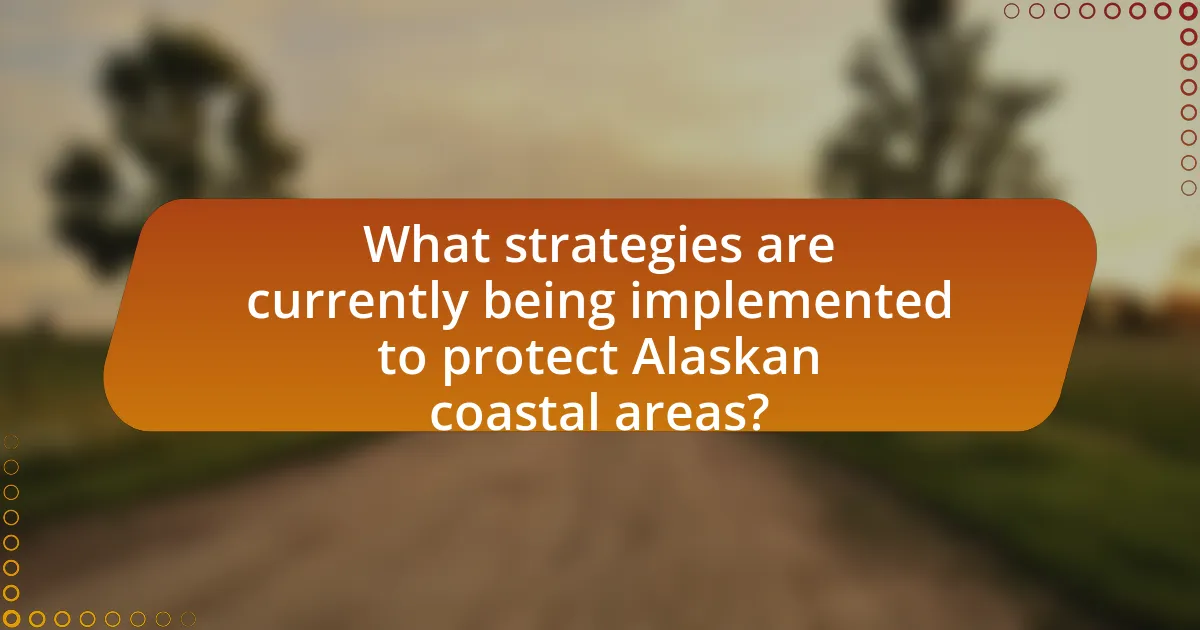
What strategies are currently being implemented to protect Alaskan coastal areas?
Current strategies to protect Alaskan coastal areas include the construction of seawalls, the implementation of managed retreat, and the restoration of natural barriers such as wetlands and dunes. Seawalls are built to absorb and deflect wave energy, thereby reducing erosion. Managed retreat involves relocating infrastructure and communities away from vulnerable coastal zones, which has been adopted in several Alaskan villages facing severe erosion. Additionally, restoring wetlands and dunes enhances natural resilience against storm surges and rising sea levels, as these ecosystems can buffer coastal areas from extreme weather events. These strategies are supported by federal and state funding, as well as community engagement initiatives aimed at addressing the impacts of climate change on coastal environments.
How effective are natural solutions like beach nourishment and vegetation restoration?
Natural solutions like beach nourishment and vegetation restoration are highly effective in mitigating coastal erosion, particularly in Alaskan coastal areas. Beach nourishment replenishes sand and enhances the beach’s natural barrier against wave action, while vegetation restoration stabilizes soil and reduces runoff, further protecting shorelines. Studies have shown that beach nourishment can reduce erosion rates by up to 50% in some regions, and vegetation can increase coastal resilience by improving habitat and reducing the impact of storm surges. These methods not only protect the coastline but also promote biodiversity and ecosystem health, making them valuable strategies in the fight against climate-related erosion.
What are the benefits of using natural barriers against erosion?
Natural barriers against erosion, such as vegetation, dunes, and wetlands, provide multiple benefits including stabilization of shorelines, enhancement of biodiversity, and reduction of storm impact. These barriers absorb wave energy, which minimizes soil loss and protects coastal infrastructure. For instance, coastal wetlands can reduce wave height by up to 50%, significantly decreasing erosion rates. Additionally, natural barriers support diverse ecosystems, which contribute to overall environmental health and resilience. Studies have shown that areas with robust natural barriers experience less erosion and better recovery from storm events compared to those without such protections.
How does vegetation contribute to coastal stability?
Vegetation contributes to coastal stability by anchoring soil and sediment, which reduces erosion caused by wave action and storm surges. The root systems of plants, such as grasses and shrubs, bind the soil together, preventing it from being washed away. Studies have shown that coastal ecosystems, including mangroves and salt marshes, can decrease wave energy by up to 70%, thereby protecting shorelines from erosion. Additionally, vegetation enhances sediment deposition, which helps build and maintain coastal landforms.
What engineered solutions are being considered or used in Alaska?
Engineered solutions being considered or used in Alaska include the construction of seawalls, revetments, and breakwaters to protect coastal areas from erosion. These structures are designed to absorb and deflect wave energy, thereby reducing the impact of storm surges and rising sea levels. For instance, the community of Shishmaref has implemented a combination of engineered barriers and relocation strategies to combat severe erosion, which has been exacerbated by climate change. Additionally, the use of geotextiles and sandbags is being explored to stabilize shorelines and provide temporary protection during extreme weather events. These solutions are supported by studies indicating that proactive measures can significantly mitigate the effects of climate-related erosion in vulnerable Alaskan communities.
What types of structures are being built to combat erosion?
To combat erosion, various structures are being built, including seawalls, revetments, breakwaters, and groins. Seawalls are vertical structures designed to absorb and reflect wave energy, protecting the shoreline from erosion. Revetments consist of sloped structures made of rock or concrete that dissipate wave energy and stabilize the beach. Breakwaters are offshore structures that create a sheltered area, reducing wave impact on the coast. Groins are built perpendicular to the shoreline to trap sand and prevent longshore drift, thereby maintaining beach width. These structures are essential in mitigating the effects of climate-related erosion in Alaskan coastal areas.
How do these engineered solutions compare to natural methods?
Engineered solutions for protecting Alaskan coastal areas from climate-related erosion, such as seawalls and breakwaters, provide immediate structural support and can be designed to withstand severe weather conditions, whereas natural methods, like restoring wetlands and planting vegetation, enhance ecosystem resilience over time. Engineered solutions often require significant financial investment and maintenance, while natural methods can be more cost-effective and sustainable in the long run, as they promote biodiversity and natural habitat restoration. Studies indicate that combining both approaches can yield optimal results, as seen in the 2018 report by the National Oceanic and Atmospheric Administration, which highlights the effectiveness of hybrid strategies in mitigating erosion while preserving ecological integrity.
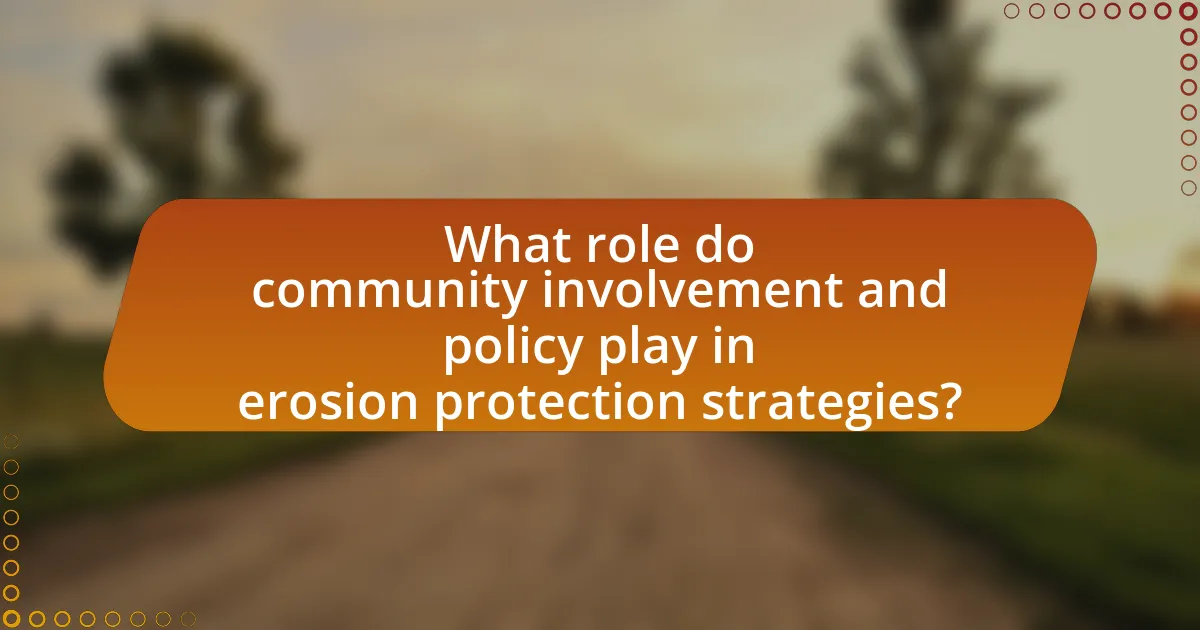
What role do community involvement and policy play in erosion protection strategies?
Community involvement and policy are crucial in erosion protection strategies as they ensure local engagement and effective governance. Local communities contribute valuable knowledge about their environment and can actively participate in decision-making processes, which enhances the relevance and acceptance of erosion control measures. Policies that support community engagement, such as the Coastal Zone Management Act, provide frameworks for collaboration between government entities and local stakeholders, facilitating the implementation of tailored erosion protection strategies. Evidence shows that areas with strong community involvement and supportive policies experience more successful erosion management outcomes, as seen in various Alaskan coastal communities where local input has led to adaptive strategies that reflect specific environmental and social contexts.
How can local communities participate in erosion management efforts?
Local communities can participate in erosion management efforts by engaging in collaborative planning, implementing local conservation practices, and monitoring erosion impacts. Community members can form partnerships with local governments and organizations to develop erosion control strategies tailored to their specific environments. For example, residents can participate in planting vegetation along shorelines, which has been shown to stabilize soil and reduce erosion rates. According to the U.S. Geological Survey, vegetation can decrease erosion by up to 50% in certain coastal areas. Additionally, communities can organize educational workshops to raise awareness about erosion issues and promote sustainable practices, thereby fostering a collective responsibility towards managing erosion effectively.
What are some successful examples of community-led initiatives?
Successful examples of community-led initiatives include the Kivalina Community’s efforts to relocate their village due to climate-related erosion and the Native Village of Eyak’s restoration projects aimed at protecting local ecosystems. The Kivalina Community has actively engaged in planning and securing funding for relocation, demonstrating resilience and adaptability in the face of climate change. The Native Village of Eyak has implemented habitat restoration projects that enhance coastal resilience, showcasing the effectiveness of local knowledge and community involvement in environmental protection. These initiatives highlight the importance of community engagement in addressing climate-related challenges in Alaskan coastal areas.
How does public awareness influence policy decisions regarding coastal protection?
Public awareness significantly influences policy decisions regarding coastal protection by shaping public opinion and mobilizing community action. When communities are informed about the risks of climate-related erosion, they are more likely to advocate for protective measures, leading policymakers to prioritize coastal protection initiatives. For instance, studies have shown that increased public engagement can result in stronger legislative support for funding and implementing coastal resilience projects, as seen in various coastal states where community-led campaigns have successfully lobbied for enhanced protective policies.
What policies are currently in place to address coastal erosion in Alaska?
The State of Alaska has implemented several policies to address coastal erosion, primarily through the Alaska Coastal Management Program (ACMP) and the Alaska Division of Geological & Geophysical Surveys (DGGS). The ACMP provides a framework for local governments to develop coastal management plans that include erosion mitigation strategies, while the DGGS conducts assessments and provides technical assistance to communities facing erosion challenges. Additionally, federal programs such as the U.S. Army Corps of Engineers’ Coastal and Hydraulics Laboratory offer funding and support for erosion control projects. These policies are designed to enhance community resilience against climate-related erosion, which has been exacerbated by rising sea levels and increased storm intensity.
How do state and federal regulations impact erosion management strategies?
State and federal regulations significantly shape erosion management strategies by establishing guidelines and standards that govern land use, construction practices, and environmental protection. These regulations, such as the Coastal Zone Management Act at the federal level and various state-specific laws, dictate how coastal areas can be developed and what measures must be taken to mitigate erosion. For instance, federal regulations may require environmental impact assessments before any construction, ensuring that erosion control measures are integrated into project planning. Additionally, state regulations often provide funding and technical assistance for local erosion management initiatives, reinforcing the importance of compliance with best practices in erosion control. This regulatory framework is crucial for protecting vulnerable coastal ecosystems and communities from the adverse effects of climate-related erosion.
What funding opportunities exist for coastal protection projects?
Funding opportunities for coastal protection projects include federal grants, state funding programs, and private sector investments. The Federal Emergency Management Agency (FEMA) provides funding through the Hazard Mitigation Grant Program, which supports projects that reduce disaster risk, including coastal erosion. Additionally, the National Oceanic and Atmospheric Administration (NOAA) offers grants for coastal resilience projects through its Coastal Zone Management Program. State governments often have specific funds allocated for coastal protection, such as Alaska’s Coastal Impact Assistance Program, which supports local initiatives. Furthermore, private foundations and organizations may provide grants for innovative coastal protection solutions, emphasizing community engagement and sustainability.
What best practices can be adopted for effective coastal erosion management?
Effective coastal erosion management can be achieved through a combination of strategies including the use of natural barriers, engineered structures, and community engagement. Natural barriers such as wetlands and dunes can absorb wave energy and reduce erosion, while engineered structures like seawalls and groins can provide immediate protection against coastal forces. Community engagement is crucial, as local knowledge and participation in decision-making enhance the effectiveness of management practices. Research indicates that integrated approaches, which combine these methods, lead to more sustainable outcomes in coastal areas, particularly in Alaska where climate change exacerbates erosion risks. For instance, the U.S. Geological Survey has documented that restoring natural habitats can significantly mitigate erosion while also providing ecological benefits.
How can stakeholders collaborate to enhance erosion protection efforts?
Stakeholders can collaborate to enhance erosion protection efforts by forming partnerships that integrate local knowledge, scientific research, and community engagement. Collaborative initiatives, such as joint funding for erosion control projects, allow stakeholders like government agencies, local communities, and environmental organizations to pool resources and expertise. For instance, the Alaska Coastal Management Program has successfully engaged various stakeholders in developing comprehensive coastal management plans that address erosion through shared strategies and funding mechanisms. This approach not only fosters a sense of ownership among local communities but also ensures that erosion protection measures are tailored to specific regional needs, thereby increasing their effectiveness.
What lessons can be learned from other regions facing similar challenges?
Regions facing similar challenges to Alaskan coastal areas, such as the Gulf Coast and Arctic regions, demonstrate the effectiveness of community engagement and adaptive management strategies. For instance, the Gulf Coast has implemented living shorelines, which use natural materials to stabilize coastlines while enhancing habitat, showing that integrating ecological solutions can mitigate erosion effectively. Additionally, the Arctic region has adopted relocation strategies for vulnerable communities, emphasizing the importance of proactive planning in response to climate impacts. These examples highlight that collaborative approaches, combining local knowledge with scientific research, can lead to sustainable solutions for coastal erosion challenges.
